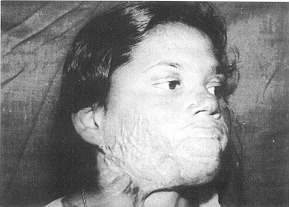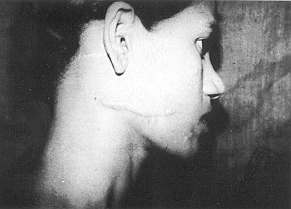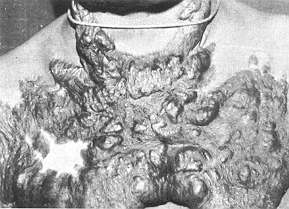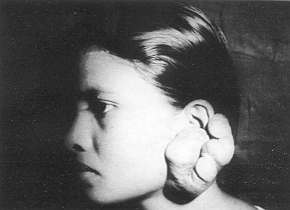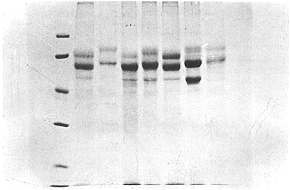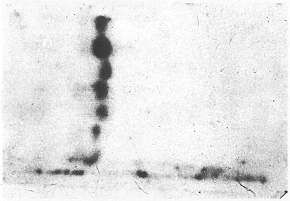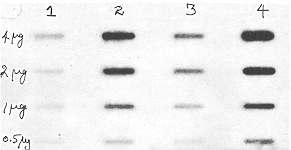| Annals ofBurns and Fire Disasters - vol. VIII - n. 4 - December
1995
EXPRESSION OF KERATIN IN POST-BURN SCARS AND KELOIDS Ramakrishnan M*, Prathiba V.**, Sridhar Rao K.***, Jayaraman V.*, Babu M.**, Gupta P.D.*** * Central Leather Research Institute,
Adyar, Madras, India SUMMARY. Keratinocyte migration is one of the initial events of re-epithelialization, and therefore an important phase of wound healing. The aim of this study was to consider the expression of keratin, which is the biochemical marker of re-epithelialization. 50 KDa and 58 KDa keratins, which are markers of proliferation, were found to be overproduced in keloids and post-bum hypertrophic scars compared to normal human skin. Introduction During epithelialization in wound
healing, keratinocytes lateral to the wound margin migrate across the wound bed to cover
it. These keratinocytes, which rest on the cutaneous basement membrane zone, migrate
upwards to the surface of the skin. During this process they start to differentiate and
synthesize keratins. Keratins are marker proteins of all epithelial cells, and are
expressed in cell and tissue in a specific manner. They are highly insoluble in most
solvents, except high urea concentrations. On the basis of the amino acid sequence, pKI
value, etc., keratins can be subdivided into two groups: type 1 keratins, which are
acidic, and type II keratins, which are basic. Materials and methods Clinical specimens The tissue samples were obtained from Child Trust Hospital, Madras, and informed consent was obtained from each patient. All the patients providing tissue for this study were of Indian origin. The lesions were diagnosed as keloids or post-burn scar on the basis of clinical appearance and also by the over-expresSiOn of fibronectin (Table I, Fig. 1). Keratin extraction. SDS-Page and Western analysis A number of 6 mm punch biopsy specimens were obtained from the tissue and left in PBS at 60 'C for 3-5 rninutes. The epidermis was peeled off and extracted once with high salt detergent solution, sonicated briefly and kept for overnight extraction. The pellet obtained on centrifugation was washed with low salt buffer. After washing, keratin was extracted by boiling the pellet in IX sample buffer containing 8M urea for 10 minutes. The extracts were subjected to SDS-PAGE1 and transferred to nitrocellulose.' Incubation of the nitrocellulose blot with polyclonal rabbit keratin antiserum was carried out with 1 in 200 dilutions in PBS solution containing 2.5% BSA at room temperature for one hour. After extensive washing with PBS containing 0.2% Tween, bound antibodies were detected by incubation with radio-iodinated protein A. Finally the nitrocellulose blot was washed extensively, dried and subjected to autoradiography. RNA extraction and hybridization Total RNA was extracted from the epidermis according to the procedure of Choinczyriski et al.' For slot-blot hybridization the RNA samples were applied onto nylon membranes. The blots were then prehybridized and hybridized with keratin cDNA. After washing, the blot was autoradiographed at -70 'C using X-ray films and intensifying screens.
Results Fig. 2 shows the SDS-PAGE analysis of keratin extracted from normal skin, post-burn hypertrophic scar (HTS) and keloids, as described in Materials and Methods. The polypeptide bands in all the tissues are seen spread in the 50-68 KDa range. There is no difference in the number of polypeptide bands in all the tissues, but it was observed in Coomassie Blue stained preparations that bands with molecular weight 58 and 50 KDa were stained densely in post-burn scar (lanes 4, 5, 6) and keloid (lane 7) when compared to normal skin (lanes 2, 3, 8). In order to cheek whether these polypeptides in SDS gels belong to keratin protein, we used polyclonal antibodies against human keratins to observe the cross-reactivity of these antibodies with the polypeptide bands. Fig. 3 shows the cross-reactivity of human antikeratin antibodies with the keratin extracted from all three different types of tissues. The 58 KDa shows thick bands in Western-blot analysis in post-burn scar and keloid tissues.
For further confirmation, RNA extracted from all the tissues was hybridized with cDNA for 50 KDa keratin. Slot-blot analysis (Fig. 4) showed that mRNA keratin is overexpressed in post-burn scar and keloid compared to normal (lanes 2 and 4 versus lanes 1 and 3). Discussion Re-epithelialization is an important
event during wound healing and is accomplished as epidermal cells migrate over the
provisional matrix provided by granulation tissue and re-establish the basement membrane.
RESUME. La migration des kératinocytes est un des premiers événements de la ré-épithélialisation et pour cette raison c'est une phase importante de la guérison des lésions. Les auteurs, dans cette étude, ont voulu considérer l'expression de la kératine, qui est le marqueur biochimique de la ré-épithélialisation. Ils ont trouvé qu'il y avait une surproduction des kératines 50 KDa et 58 KDa, qui sont les marqueurs de la prolifération, dans les chéloïdes et les cicatrices hypertrophiques dues aux brûlures en comparaison de la peau humaine normale. BIBLIOGRAPHY
|
